2023 Volume 57 Issue 1 Pages 1-12
2023 Volume 57 Issue 1 Pages 1-12
Megacrystic phengite-bearing quartz veins associated with retrogressed eclogites occur along terrane boundary zone in the northern Ross orogen, Antarctica. The vein zircons crystallized from metamorphic fluid under high-pressure (P) conditions rather than captured as xenocrysts from the host eclogites, on the basis of: (1) weak oscillatory- and fir tree-zoned cathodoluminescence textures and extremely low Th/U ratios of zircon, (2) highly steep patterns of heavy rare earth elements and weak negative to positive Eu anomaly of zircons, suggesting their growth not in equilibrium with garnet and plagioclase, respectively; and (3) the high celadonite contents of phengite megacrysts (up to 3.33 a.p.f.u. Si for O = 11). Zircon U-Pb ages dated the high-P quartz vein formation at 501 ± 7 Ma (2σ), which overlaps with time of peak metamorphism of the eclogites at c. 500–498 Ma. The zircon crystallization age and marginal breakdown of phengite megacrysts into biotite–oligoclase symplectites suggest that the high-P quartz vein formation was at near-peak to early-exhumation stages of the eclogite facies metamorphism. The similarity in depths of the vein formation and major dehydration of subducting metamafic rocks further suggests that this fluid activity would be one of possible agents responsible for arc-related magmatism in northern Victoria Land of the Ross orogen.
Fluid flow of variable scales is a major driver for element recycling and heat-mass transfer in subduction zones, significantly affecting thermo-chemical evolution of arc-related magma and lithosphere (e.g., Manning, 2004; Poli and Schmidt, 2002; Spandler and Pirard, 2013; Zheng, 2012). In addition, fluid activity would cause rheological weakening of the invaded host rocks, thereby triggering earthquake (e.g., Hacker et al., 2003; John and Schenk, 2006) and facilitating exhumation of (ultra)high-pressure (P) rocks (e.g., Labrousse et al., 2015; Rosenberg and Handy, 2005). In order to better understand these fluid-related processes, it is important to unravel the generation and evolution of fluids from exhumed (ultra)high-P metamorphic rocks. In particular, veins comprising eclogitic minerals are a notable sign of fluid flow in ancient (ultra)high-P terranes (e.g., Franz et al., 2001; Guo et al., 2019; Harlow et al., 2015; Philippot and Selverstone, 1991; Rubatto and Hermann, 2003; Wu et al., 2009; Zheng et al., 2007).
Quartz veins are the most common in eclogite-bearing terranes, and would provide valuable information for source, composition, and evolution of subduction-zone fluids (e.g., Chen et al., 2012; Rubatto and Hermann, 2003; Wu et al., 2009; Zhao et al., 2016; Zheng et al., 2007). However, a comprehensive understanding on mechanisms and time frame of the vein formation or fluid activity is generally hard to achieve. It is mostly because the high-P veins often have complex petrologic history including post-emplacement re-equilibration during exhumation (e.g., Franz et al., 2001; Spandler et al., 2011), and because physical-chemical properties of high-P fluid largely vary for aqueous fluid, hydrous melt and supercritical fluid (Kawamoto et al., 2012; Manning, 2004; Shmulovich et al., 2006; Spandler and Pirard, 2013; Takahashi et al., 2022).
Zircon, a robust geochronometer, has been reported in many high- to ultrahigh-P rocks and associated veins; the vein formation and zircon growth were attributed to deep fluid activities (e.g., Rubatto and Hermann, 2003; Wu et al., 2009; Zheng et al., 2007). This accessory mineral in the eclogitie facies veins could record not only times of vein formation but also other geochemical tracers such as O-Hf isotopic and rare earth element (REE) compositions of original fluids (Spandler et al., 2011; Zhao et al., 2016). The vein zircons could form either by dissolution-precipitation of relict zircon captured from host eclogites, or by direct precipitation from the vein-forming fluid (e.g., Hoskin, 2005; Pettke et al., 2005; Xia et al., 2010). In addition, the veins and zircons therein crystallize during the entire stages of subduction-zone metamorphism; prograde (e.g., Franz et al., 2001; Gauthiez-Putallaz et al., 2016; Rubatto et al., 1999), peak (e.g., Rubatto and Hermann, 2003; Xia et al., 2010; Zack and John, 2007) and retrograde phases (e.g., Chen et al., 2012; Zhao et al., 2016; Zheng et al., 2007). Thus, it is prerequisite to constrain paragenesis and time of zircon growth in the presence of vein-forming fluids, in order to better understand evolution of deep fluid activity and its effects on host eclogitic rocks.
In this study, we analyzed U-Pb isotopic and REE compositions of zircon from megacrystic phengite-bearing quartz vein in the Lanterman Range, one of rare localities of eclogite occurrence in the late Neoproterozoic to Ordovician Ross orogen, Antarctica (e.g., Brown et al., 2020; Di Vincenzo et al., 1997). Our results provide evidence for the zircon growth from the vein-forming fluids, excluding the possibility of xenocrysts from host eclogites, and for near-peak fluid activity under the eclogite facies conditions in terrane boundary zone at the Pacific end of the orogen.
Southwestward subduction of the paleo-Pacific plate beneath the East Antarctic margin resulted in the formation of the late Neoproterozoic–Ordovician Ross orogen, now constituting a crustal root of the Transantarctic Mountains (Fig. 1a) (e.g., Goodge, 2020; Stump, 1995). Northern Victoria Land, situated at the Pacific end of the orogen, consists of NW-trending, fault-bounded blocks of the Wilson, Bowers and Robertson Bay terranes from onshore to offshore (e.g., GANOVEX TEAM, 1987; Kleinschmidt and Tessensohn, 1987; Tessensohn and Henjes-Kunst, 2005). The onshore Wilson terrane is a continental arc complex which primarily consists of metasedimentary rocks of low-grade to migmatitic conditions, the Wilson metamorphic complex, and intruding Middle Cambrian to Early Ordovician syn- to post-orogenic plutons, the Granite Harbour intrusives (Fig. 1b) (e.g., Bomparola et al., 2007; Borg et al., 1987; Palmeri, 1997; Talarico et al., 2004). The weakly metamorphosed Bowers terrane forms an elongate belt (~20–30 km wide) of, in stratigraphic order, Early to Middle Cambrian volcanic-volcaniclastic sequences of island arc or back-/fore-arc setting, and molasse-type siliciclastic sediments of Late Cambrian to Early Ordovician age (e.g., Jago et al., 2019; Weaver et al., 1984; Wodzicki and Robert Jr, 1986). The outboard Robertson Bay terrane comprises variably folded, flysch-type turbiditic sequences of Late Cambrian to Early Ordovician age (e.g., Buggisch and Repetski, 1987; Field and Findlay, 1983).
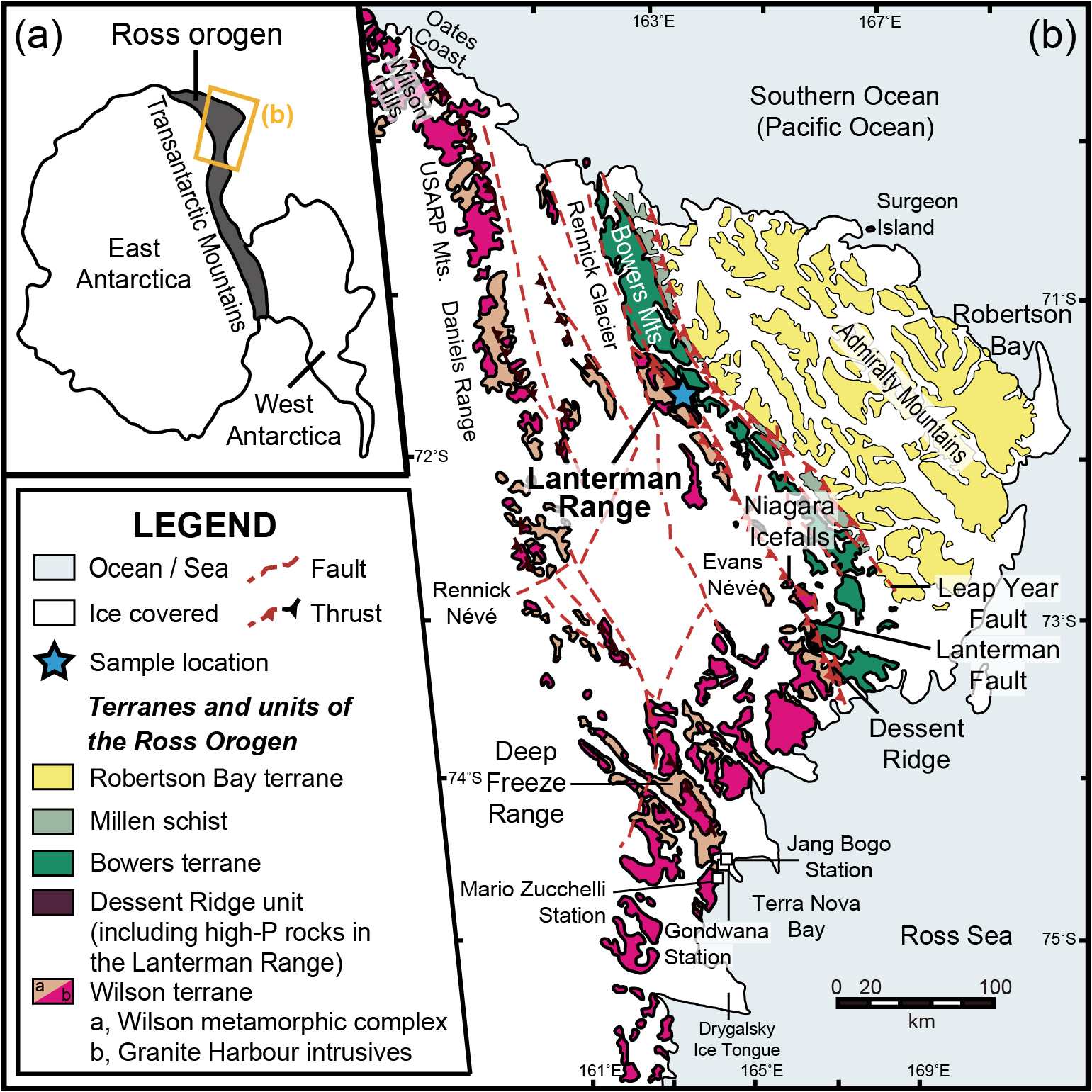
(a) Schematic map of the Ross orogen of the Transantarctic Mountains. An orange box denotes the location of northern Victoria Land enlarged in (b). (b) Tectonic province map of northern Victoria Land, modified from Läufer et al. (2011) showing key lithotectonic elements of three terranes and two intervening belts or units. The sample location in the Lanterman Range is denoted as blue star. The post-Ross rocks were omitted for clarity.
The accretion of the Bowers terrane onto the Wilson terrane along NW-SE trending Lanterman Fault resulted in the formation of the Dessent Ridge unit, which is primarily composed of medium-P amphibolites and metapelites to the southeast (Palmeri et al., 2012; Scambelluri et al., 2003) and eclogite facies rocks of the Lanterman Range to the northwest (Fig. 1b) (e.g., Di Vincenzo et al., 1997; Kim et al., 2019; Palmeri et al., 2003). The latter high-P rocks including eclogites and surrounding garnet–phengite quartzofeldspathic schists/gneisses constitute the Gateway Hills metamorphic complex (Fig. 2a) (Talarico et al., 1998). Arc-related granitoids occur along the western part of the Lanterman Range, and the Bowers terrane sequences and Jurassic Ferrar dolerite–Beacon supergroup rocks limitedly occur to the northeast and central parts of the range, respectively (Fig. 2a) (Capponi et al., 1997).
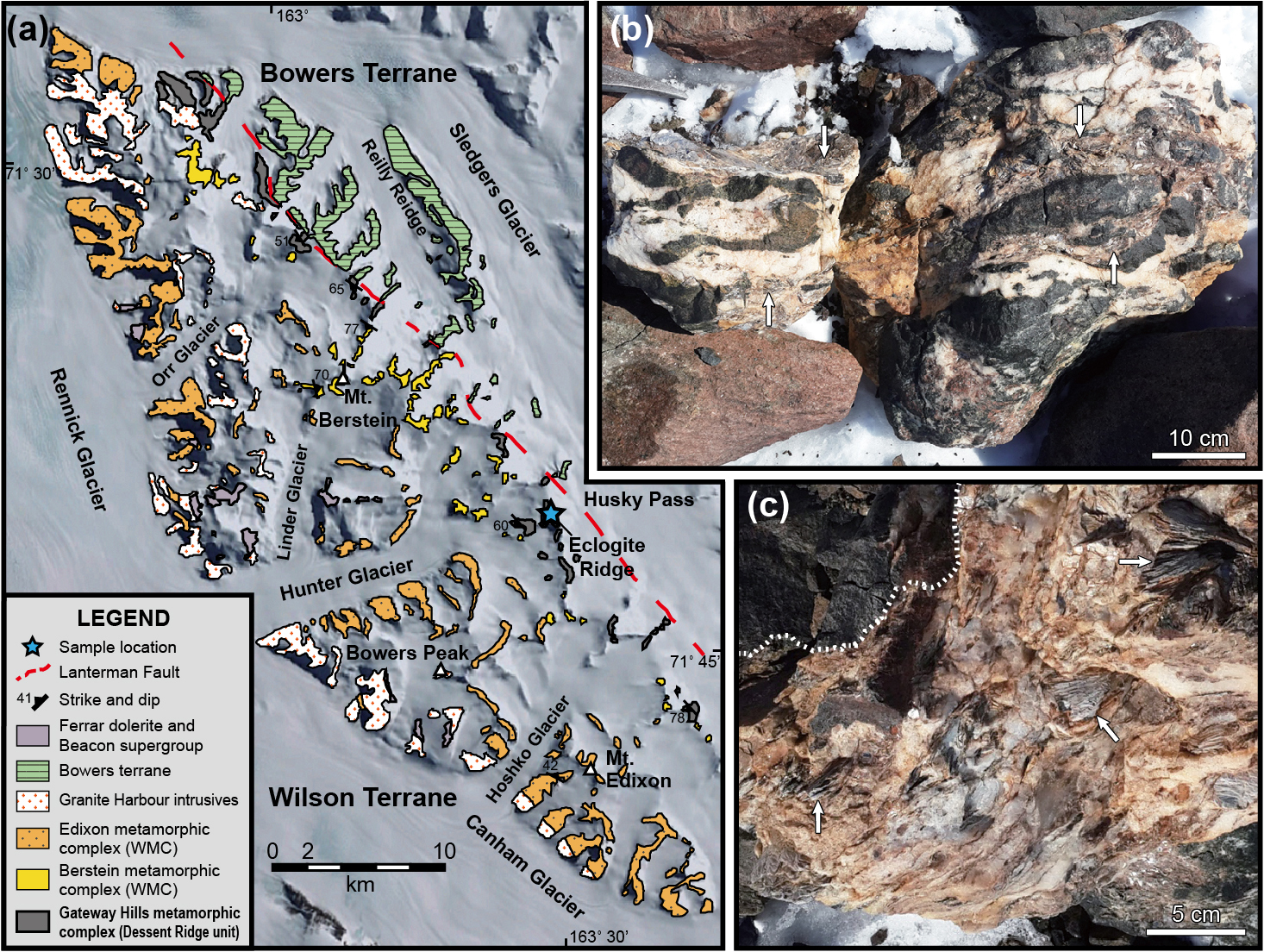
(a) Geological map of the Lanterman Range, northern Victoria Land, modified from Roland et al. (1984) and GANOVEX TEAM (1987), put on the Google Earth image. A blue star denotes the Eclogite Ridge where the megacrystic phengite-bearing quartz vein sample (26-7) was collected (71°40′54.73″S, 163°27′34.47″E). (b, c) Outcrop photographs showing relationships between the megacrystic phengite-bearing quartz vein and host retrogressed eclogites. The phengite megacrysts are denoted by white arrows. In (c), a broken line denotes lithologic boundaries. WMC: Wilson metamorphic complex.
The eclogites and their retrograde products only occur along a ridge near Husky Pass area, the so-called Eclogite Ridge (Fig. 2a) (Capponi et al., 1997; Di Vincenzo et al., 1997). Variably deformed lenses or boudins of the eclogites and garnet amphibolites are commonly enveloped by the garnet–phengite quartzofeldspathic gneisses/schists and hornblende–biotite gneisses (Fig. 2b) (e.g., Di Vincenzo et al., 1997; Kim et al., 2019; Palmeri et al., 2003). Two distinctive types of the eclogites were revealed: (1) high-temperature (T) eclogites metamorphosed at ~800°C and coesite-stable peak pressure (Di Vincenzo et al., 1997; Ghiribelli et al., 2002); and (2) medium-T eclogites recording quartz-stable peak conditions at ~1.7–2.6 GPa and 700°C (Di Vincenzo et al., 2016; Kim et al., 2019). The ultrahigh-P peak stage of the high-T eclogites was dated by Sm-Nd isochrons at 500 ± 5 Ma (Fig. 3) (Di Vincenzo et al., 1997). In contrast, U-Pb geochronology on zircons of the medium-T eclogites yielded two different scenarios (Fig. 3); prolonged high-P zircon recrystallization during c. 530–500 Ma range (Di Vincenzo et al., 2016) vs. episodic growth of eclogitic zircons during two distinct high-P stages at 515 ± 4 Ma and 498 ± 11 Ma, respectively (Kim et al., 2019). The igneous cores of the latter zircons also yielded the crystallization ages of mafic protoliths of the medium-T eclogites at 605 ± 5 Ma and 591 ± 5 Ma (Kim et al., 2023).
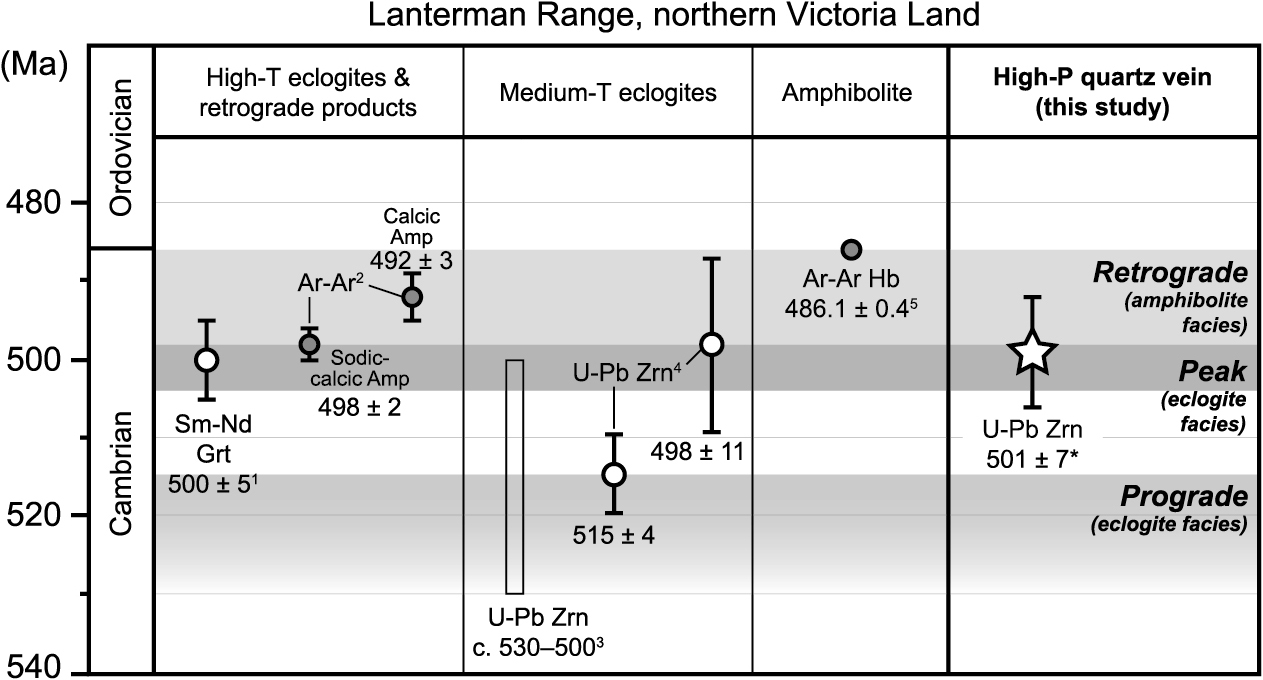
Time-line diagram representing metamorphic stages of the high-pressure rocks in the Lanterman Range, based on geochronologic data (weighted mean age in Ma, 2σ, except for (3)) from this study (*) together with those compiled from the literature: (1) Di Vincenzo et al. (1997); (2) Di Vincenzo and Palmeri (2001); (3) Di Vincenzo et al. (2016); (4) Kim et al. (2019); and (5) Goodge and Dallmeyer (1996). A box for (3) denotes of a range of apparent ages (1σ). Error bar of (5) is not shown because of its smaller size than that of symbol. Time intervals are marked for the eclogite facies prograde-peak and amphibolite facies retrograde stages. Mineral abbreviations are after Whitney and Evans (2010).
Two stages of the amphibolite facies retrogression were defined in the high-T eclogites and surrounding garnet–phengite quartzofeldspathic gneisses; medium- and low-P stages at ~0.7–1.0 GPa/630–750°C and ~0.3–0.5 GPa/550–650°C, respectively (Di Vincenzo et al., 1997; Palmeri et al., 2003). Cooling and exhumation initiated rapidly near metamorphic peak at 498 ± 2 Ma followed by further decompression at c. 490–486 Ma (Fig. 3); average rates were estimated to be >30°C·Ma–1 and ~2–5 km·Ma–1, respectively (Di Vincenzo and Palmeri, 2001; Di Vincenzo et al., 2001; Goodge and Dallmeyer, 1996).
Quartz veins commonly occur in a boudin neck of elongate-shaped mafic blocks and as layers subparallel or oblique to the major foliation of the host eclogites and quartzofeldspathic gneisses. We concentrated on the quartz veins with megacrystic phengite in order to delineate high-P fluid activity. Hereafter, we used the term ‘quartz veins’ for the megacrystic phengite-bearing quartz veins. The quartz vein sample (26-7) was collected from ‘outcrop 4’ of the Eclogite Ridge, following the geological map of Capponi et al. (1997) (Fig. 2a). The quartz veins are commonly transposed together with the variably retrogressed eclogites, i.e., garnet amphibolites (Fig. 2b–c). The metamafic rocks are boudinaged or strongly folded, showing isoclinal fold structures (Fig. 2b).
Mineral assemblages of the garnet amphibolites consist primarily of garnet, Mg-hornblende/-pargasite, and plagioclase, together with minor amounts of omphacite, rutile, ilmenite and titanite. The garnet xenoblasts, and minor amounts of omphacite relicts, are surrounded by amphibole–plagioclase corona. Ilmenite ± rutile grains are enveloped by titanite rims. The quartz veins are commonly oriented sub-parallel to the major foliation of the host garnet amphibolites. The boundary zones between the quartz veins and garnet amphibolites are transitional and irregular, and consist of two boundary-parallel domains with different modes of amphibole–epidote–biotite–plagioclase assemblages (Fig. 4a). The quartz vein side of the boundary primarily consists of biotite–plagioclase symplectites, whereas the host amphibolite side of amphibole–plagioclase intergrowths together with minor amounts of biotite; epidote xenoblasts occur between the two boundary zones (Fig. 4a).
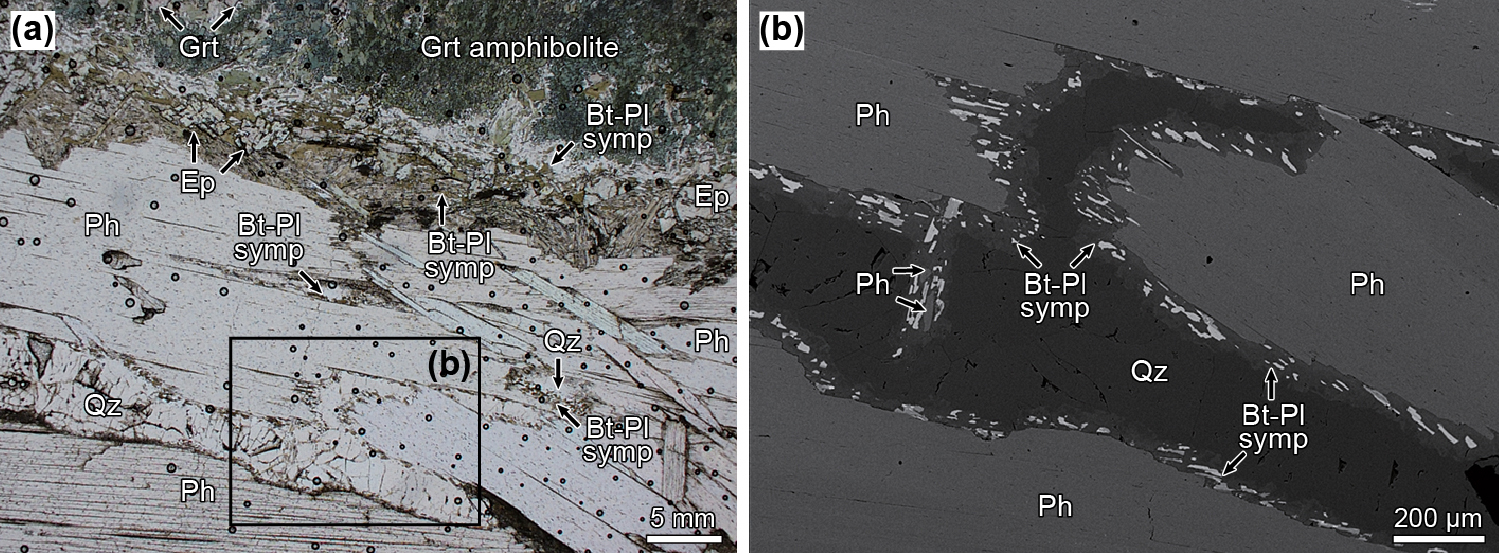
(a) Photomicrograph of marginal zone of the quartz vein rich in phengite megacrysts (sample 26-7; taken under plane-polarized light). Boundary between the quartz vein and garnet amphibolite consists of epidote and biotite–plagioclase symplectites (symp). A box is enlarged in (b). (b) Backscattered electron image showing breakdown textures of phengite into the symplectites. Mineral abbreviations are after Whitney and Evans (2010).
The studied quartz veins with megacrystic phengite are mostly bimineralic, together with minor amounts of biotite–plagioclase intergrowth replacing precursor phengite (Fig. 4). Phengite megacrysts or booklets are mm to cm in size, up to ~10 cm. Accessory phases include rutile, epidote and zircon. Quartz grains are granoblastic and mm-sized, except for those of finer grain size pinned by phengite. Weak undulose extinction, subgrain boundaries and fluid inclusion trails are commonly observed in quartz.
Mineral compositions of a megacrystic phengite-bearing quartz vein (sample 26-7) were analyzed using a JEOL JXA-8530F field-emission electron microprobe housed at the Korea Polar Research Institute, with 15 kV accelerating voltage, 10 nA beam current, 3 μm beam diameter and 20 s counting times. Standard materials used for calibration include natural silicates and synthetic oxides and the ZAF correction was used. Representative analyses of individual minerals are given in Table 1, whereas those of the host garnet amphibolite are in Table S1.
| sample 26-7 | Phengite | Biotite | Plagioclase | |||||||
|---|---|---|---|---|---|---|---|---|---|---|
| inner zone | outer zone | |||||||||
| SiO2 | 49.30 | 49.52 | 48.84 | 49.14 | 36.32 | 36.85 | 36.47 | 62.40 | 63.13 | 62.99 |
| TiO2 | 0.67 | 0.74 | 0.59 | 0.54 | 2.25 | 3.41 | 2.23 | 0.03 | 0.02 | 0.01 |
| Al2O3 | 28.94 | 28.16 | 29.99 | 29.20 | 18.13 | 16.70 | 18.03 | 24.18 | 23.77 | 23.73 |
| Cr2O3 | b.d. | b.d. | b.d. | b.d. | b.d. | b.d. | b.d. | b.d. | b.d. | b.d. |
| FeO* | 2.19 | 2.48 | 2.27 | 2.33 | 16.04 | 16.21 | 15.61 | 0.14 | 0.13 | 0.16 |
| MnO | 0.05 | 0.04 | 0.01 | 0.06 | 0.16 | 0.20 | 0.20 | 0.01 | 0.07 | 0.02 |
| MgO | 2.79 | 3.06 | 2.63 | 2.78 | 12.04 | 11.75 | 11.96 | 0.07 | 0.04 | 0.07 |
| CaO | b.d. | b.d. | b.d. | b.d. | b.d. | b.d. | b.d. | 5.10 | 4.49 | 4.54 |
| Na2O | 0.52 | 0.47 | 0.97 | 0.63 | 0.17 | 0.13 | 0.12 | 8.88 | 9.18 | 8.91 |
| K2O | 10.51 | 10.28 | 9.61 | 10.23 | 9.68 | 9.76 | 9.87 | 0.07 | 0.09 | 0.12 |
| Total | 94.99 | 94.80 | 94.90 | 94.91 | 94.91 | 95.07 | 94.61 | 100.88 | 100.90 | 100.56 |
| Cations per 11 and 8 oxygens for micas and plagioclase, respectively. | ||||||||||
| Si | 3.31 | 3.33 | 3.27 | 3.30 | 2.74 | 2.78 | 2.75 | 2.74 | 2.77 | 2.77 |
| AlIV | 0.69 | 0.67 | 0.73 | 0.70 | 1.26 | 1.22 | 1.25 | 0.26 | 0.23 | 0.23 |
| AlVI | 1.59 | 1.56 | 1.63 | 1.60 | 0.34 | 0.26 | 0.36 | 1.00 | 1.00 | 1.00 |
| Cr | b.d. | b.d. | b.d. | b.d. | b.d. | b.d. | b.d. | b.d. | b.d. | b.d. |
| Ti | 0.03 | 0.04 | 0.03 | 0.03 | 0.13 | 0.19 | 0.13 | 0.00 | 0.00 | 0.00 |
| Fe2+ | 0.12 | 0.14 | 0.13 | 0.13 | 1.01 | 1.02 | 0.99 | 0.01 | 0.00 | 0.01 |
| Mn | 0.00 | 0.00 | 0.00 | 0.00 | 0.01 | 0.01 | 0.01 | 0.00 | 0.00 | 0.00 |
| Mg | 0.28 | 0.31 | 0.26 | 0.28 | 1.35 | 1.32 | 1.35 | 0.00 | 0.00 | 0.00 |
| Ca | b.d. | b.d. | b.d. | b.d. | b.d. | b.d. | b.d. | 0.24 | 0.21 | 0.21 |
| Na | 0.07 | 0.06 | 0.13 | 0.08 | 0.02 | 0.02 | 0.02 | 0.76 | 0.78 | 0.76 |
| K | 0.90 | 0.88 | 0.82 | 0.88 | 0.93 | 0.94 | 0.95 | 0.00 | 0.01 | 0.01 |
| Total | 7.00 | 6.99 | 6.99 | 7.00 | 7.81 | 7.77 | 7.80 | 5.01 | 5.01 | 5.00 |
| XFe | 0.31 | 0.31 | 0.33 | 0.32 | 0.43 | 0.44 | 0.42 | — | — | — |
| An | — | — | — | — | — | — | — | 0.24 | 0.21 | 0.22 |
| Ab | — | — | — | — | — | — | — | 0.76 | 0.78 | 0.77 |
| Or | — | — | — | — | — | — | — | 0.00 | 0.01 | 0.01 |
*Total Fe as FeO.
b.d., below detection limit; XFe = Fe2+/(Fe2+ + Mg); An = Ca/M, Ab = Na/M, and Or = K/M, where M = Ca + Na + K.
Zircon separates were collected from the quartz vein (sample 26-7) using a conventional technique (Cheong et al., 2013). Hand-picked zircon grains were mounted in epoxy disc with SL13 and FC-1 standard zircon crystals. The former was used for measuring the U concentration (238 μg/g) (Claoué-Long et al., 1995), and the latter for calibrating 206Pb/238U ratios (206Pb*/238U = 0.1859) (Paces and Miller, 1993), respectively. The cathodoluminescence (CL) images of zircon crystals were obtained using a JEOL JSM-6610LV scanning electron microscope housed at the Korea Basic Science Institute (KBSI). The U-Pb isotopic compositions of zircon were measured using the sensitive high-resolution ion microprobe (SHRIMP)-IIe at the KBSI. All isotopes were measured using a primary O2– beam with ~3–5 nA and ~25 μm diameter spot. Common Pb contributions to total Pb counts were corrected using the 207Pb correction method based on the Pb/U concordance and model common Pb composition (Cumming and Richards, 1975; Williams, 1998). The isotopic data were reduced using the Squid 2 software, and were plotted using the program Isoplot/Ex (Ludwig, 2008). The weighted mean 206Pb/238U ages of zircon are quoted at 2σ confidence level.
The REE compositions of zircon from the quartz vein (sample 26-7) were measured on the same spots used for the SHRIMP U-Pb analyses, using the same KBSI SHRIMP-IIe machine. The analyses were carried out in the energy filtering mode following procedures of Hoskin (1998). The NIST glass was used in order to determine REE peaks and interferences, and to derive sensitivity factors for calculating the concentrations. Reference zircons were analyzed in conjunction with the unknowns; 91500 (Whitehouse, 2004) as primary, and Plešovice (Sláma et al., 2008) and Temora (Black et al., 2004) as secondary standards, respectively. The spot diameter was ~25 μm. All of the zircon U-Pb and REE data are listed in Tables S2 and S3, respectively.
The compositions of phengite megacrysts in the quartz vein (sample 26-7) are nearly homogeneous (Table 1). The celadonite component slightly decreases from the inner (3.30–3.33 Si a.p.f.u. for O = 11) to outer zones (3.27–3.30 Si a.p.f.u.) (Fig. 5). Stoichiometric Fe3+ was not calculated because of possible octahedral vacancy and O–OH substitution (Page et al., 2007), although the excess Fe + Mg relative to Si (= Fe + Mg – (Si – 3) = 0.10–0.13) indicates the presence of the ferri-muscovite component (Giorgetti et al., 2000). The Ti content of phengite is low (0.03–0.04 a.p.f.u.).
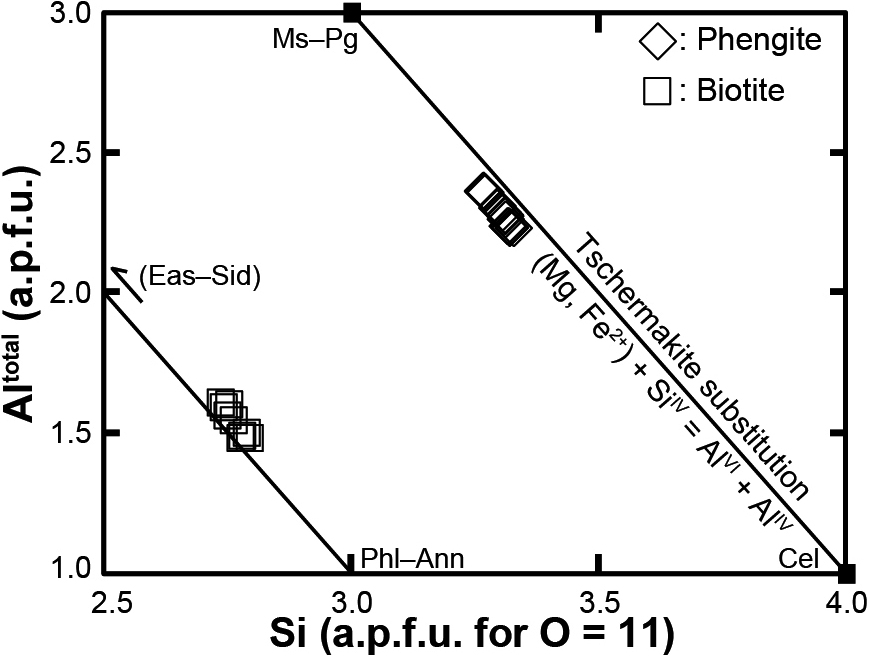
Compositional diagram of phengite and biotite. Mineral abbreviations are after Whitney and Evans (2010), except for Sid for siderophyllite.
Biotite grains intergrown with plagioclase, replacing phengite along its boundary, are intermediate between phlogopite and eastonite in composition, yielding the XFe values (= Fe/(Fe + Mg)) of 0.42–0.44 and Ti contents of 0.13–0.19 a.p.f.u. (Table 1 and Fig. 5). No systematic variation in composition associated with petrographic domain was detected.
Post-eclogite stage plagioclasePlagioclase forming the symplectitic intergrowth with biotite is oligoclase in composition (An = Ca/(Ca + Na + K) = 0.21–0.24) (Table 1). The orthoclase component is negligible (Or = K/(Ca + Na + K) < 0.02). No significant zonation is observed for plagioclase.
Zircon U-Pb age and REE compositionZircons separated from a megacrystic phengite-bearing quartz vein (sample 26-7) are commonly prismatic, and ~50–300 μm in size with aspect ratio of 1:1–1:3 (Fig. 6a). Most zircons show fine oscillatory, sector or fir-tree zonation under CL. Some equant zircons show structureless, low-luminescent cores. Zircon grains commonly enclose mineral inclusions such as garnet, omphacite, rutile, apatite and quartz (Fig. 6a). It is notable that these eclogitic minerals are absent in the matrix of the quartz vein, except for trace amounts of rutile.
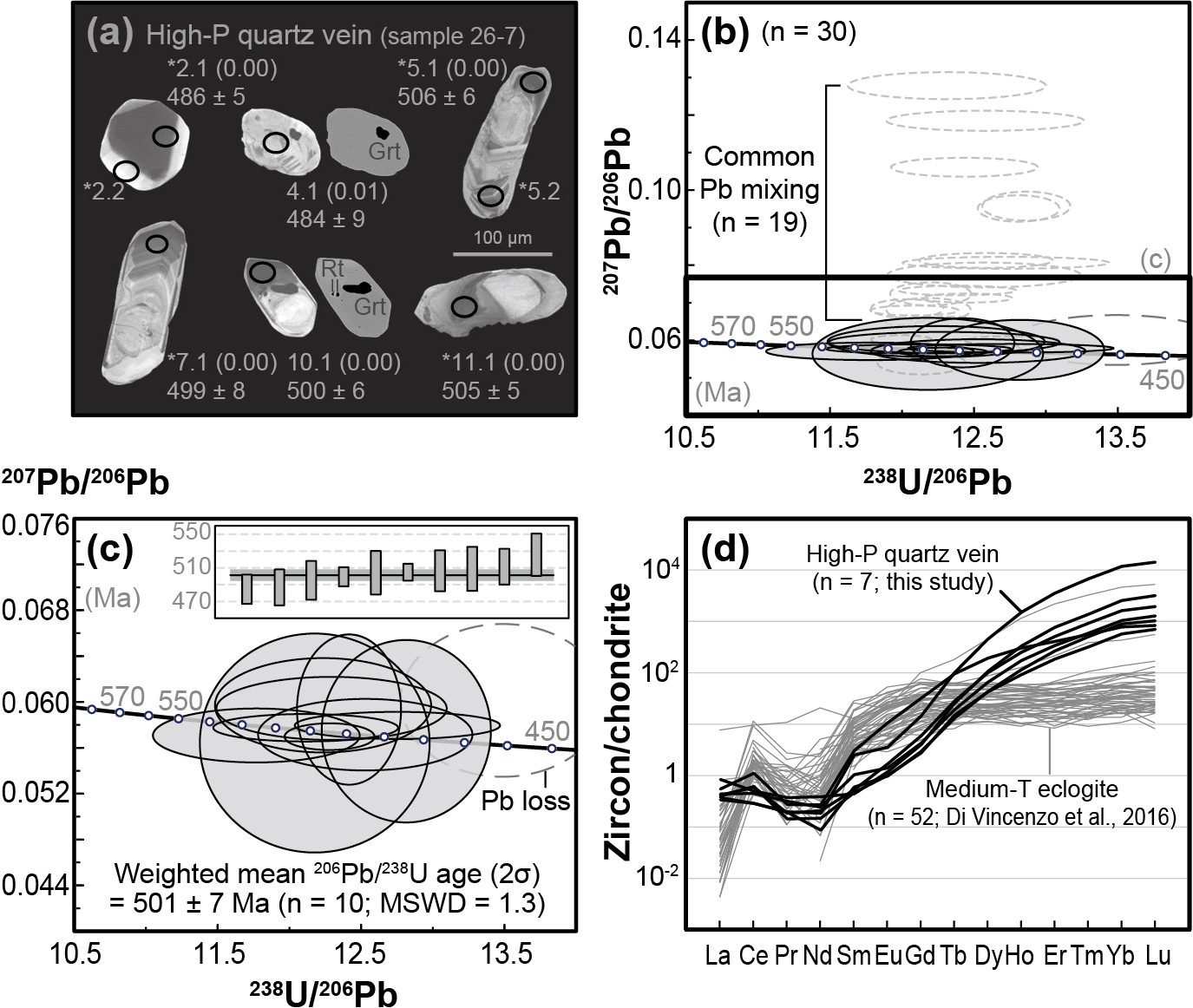
(a) Representative cathodoluminescence and backscattered electron images (BEI) of zircon from the megacrystic phengite-bearing quartz vein (sample 26-7). Spot numbers for the U-Pb and rare earth element (REE) analyses listed in Tables S2 and S3 are shown for individual zircon grains, followed by their Th/U ratios in parentheses. The bottom lines list the 206Pb/238U dates (in Ma) with 1σ errors. Spot numbers with asterisk are those analyzed for REE compositions, given in Table S3. Ellipses denote the analytical spots. Mineral inclusions of garnet (Grt) and rutile (Rt) are denoted in the BEI. (b, c) Tera–Wasserburg concordia diagrams showing U-Pb isotopic compositions. Error ellipses are 2σ. Dashed ellipses denote spot analyses that are excluded in the mean age calculation. Inset diagram in (c) shows the error bars (in 2σ) of each 206Pb/238U date for the weighted mean age calculation. (d) The REE patterns normalized to values of chondrite (Sun and McDonough, 1989). Dark and gray lines denote zircon REE patterns of the high-P quartz vein (this study) and medium-T eclogite (sample GL10; Di Vincenzo et al., 2016), respectively.
The U-Th-Pb isotopic compositions of 30 spots measured on 36 zircon crystals are shown in the Tera–Wasserburg concordia diagram, except for six erroneous data (Fig. 6b, c and Table S2). The analyses yielded intermediate and low concentrations of U (11–641 μg/g; med. 117 μg/g) and Th (<2.0 μg/g, except for a spot 19.1; med. 0.1 μg/g), respectively, and extremely low Th/U ratios (<0.029, except for the spot 19.1; med. 0.001). Nineteen analyses with >15% discordance were rejected because of common Pb mixing (Fig. 6b). A spot analysis (spot 1.1) was also ignored on the basis of fairly young apparent age (461 ± 10 Ma, 1σ) possibly affected by Pb loss. The U-Pb isotopic compositions of the remaining 10 analyses yielded a weighted mean 206Pb/238U age of 501 ± 7 Ma (MSWD = 1.3; Fig. 6c).
The chondrite-normalized REE patterns (Fig. 6d and Table S3) of seven spot analyses is characterized by: (1) relative depletion of light (L) REE and strong depression of positive Ce anomaly (Ce/Ce* = 0.90–2.88, med. 1.20), (2) weak negative to positive Eu anomaly (Eu/Eu* = 0.59–1.08, med. 0.89), and (3) highly steep slope from middle REE to heavy (H) REE (LuN/GdN = 26–992, med. 329). These features are in marked contrast to the HREE depleted patterns of high-P zircons of the medium-T eclogite in the study area (Fig. 6d) (Di Vincenzo et al., 2016).
The fine oscillatory, sector or fir-tree zonations under CL and euhedral crystal shapes of zircons (Fig. 6a) from the megacrystic phengite-bearing quartz vein suggest zircon precipitation from silica-rich metamorphic fluids responsible for the vein formation (Corfu et al., 2003; Liati and Gebauer, 1999; Rubatto, 2002). We rule out the possibility of zircon xenocrysts from the host eclogites (cf. Chen et al., 2012; Spandler et al., 2011; Zhao et al., 2016), because: (1) CL textures are distinctly different from those of Cambrian metamorphic zircons of the medium-T eclogites in the study area (Di Vincenzo et al., 1997, 2016; Kim et al., 2019, 2023); (2) the prismatic and ~50–300 μm-sized vein zircons are distinguishable from the rounded small (≤60 μm) zircons of the medium-T eclogite (sample GL10; Di Vincenzo et al., 2016); and (3) the HREE patterns of the vein zircons exhibit highly positive slope (med. LuN/GdN = 329) (Fig. 6d), in marked contrast to flattened HREE patterns of the medium-T eclogite zircons (med. LuN/GdN = 1.6; Di Vincenzo et al., 2016). We note that the fir-tree zonation of zircon in the medium-T eclogite (Di Vincenzo et al., 2016) may indicate fluid-driven zircon growth and/or recrystallization. Extremely low Th/U ratios (med. 0.001) of the vein zircon and the absence of partial melting textures in the host eclogitic rocks (Di Vincenzo et al., 2016; Kim et al., 2019) further support their growth in the presence of subsolidus fluid (e.g., Hermann et al., 2006; Rubatto and Hermann, 2003; Rubatto et al., 1999).
The weak negative to positive anomaly of Eu and highly positive slope of HREE of the vein zircons (Fig. 6d) suggest their crystallization not in equilibrium with plagioclase and garnet, respectively (Kohn, 2016; Rubatto, 2002; Whitehouse and Platt, 2003). The former feature is consistent with feldspar-absent, high-P assemblage, whereas the latter in marked contrast to common HREE-depleted metamorphic zircons of the eclogite facies paragenesis (e.g., Di Vincenzo et al., 2016; Rubatto, 2002). Although eclogitic minerals are absent in the vein matrix, except for rutile, their presence as inclusions enclosed by zircon and the high celadonite component of the phengite megacrysts (up to 3.33 a.p.f.u. Si; Fig. 5) supports the high-P conditions for the formation of quartz vein and zircon precipitates. The presence of garnet inclusion, particularly, in the vein zircons would not contradict their enrichment patterns of HREE, because the amounts of garnet inclusions are minor (e.g., Gauthiez-Putallaz et al., 2016).
The depletion of LREE in the vein zircons has been reported from hydrothermal zircon precipitated from metamorphic fluids and zircons crystallized together with LREE-rich phases such as titanite, monazite and allanite (Pettke et al., 2005; Rubatto et al., 2009; Xia et al., 2010). The latter minerals are not observed in the quartz vein matrix, but the presence of small amounts of allanite would be inferred; similar to the Monviso meta-ophiolite case of Western Alps, where the presence of allanite was predicted in the eclogite facies vein on the basis of mass balance calculation on LREE and Th (Rubatto and Hermann, 2003). The high abundance of allanite in both the host eclogites and surrounding garnet–phengite quartzofeldspathic gneisses is noteworthy (Di Vincenzo et al., 1997; Kim et al., 2019; Palmeri et al., 2003). The allanite buffering effect would be also responsible for fairly low Th/U ratio (med. 0.001) of the high-P quartz vein zircons (Hermann, 2002), as well as depression of their positive Ce anomaly (med. Ce/Ce* = 1.20; Fig. 6d). The latter feature may be attributed to relatively low oxygen fugacity of the vein-forming fluid as well (e.g., Pettke et al., 2005).
Formation conditions of the high-P quartz veinThe breakdown of phengite megacrysts in the quartz vein by the intergrown biotite and plagioclase (Fig. 4) suggests decompressional recrystallization under the amphibolite facies conditions during exhumation. The phengite breakdown reaction is similar to that of Franz et al. (1986): phengite + quartz + Na+ + Ca2+ + Fe2+ = biotite + oligoclase + K+ + H2O, the cation components and H2O in fluid phase. Phengite in the garnet–phengite quartzofeldspathic gneisses in the study area also exhibits similar textures of marginal decomposition into the biotite–plagioclase symplectites (e.g., Godard, 2001; Palmeri et al., 2003), and the metamafic rocks associated with the megacrystic phengite-bearing quartz veins were also variably retrogressed to garnet amphibolites (Fig. 2b and 4a).
These lines of evidence for the amphibolite facies retrogression in the study area suggest coeval evolution of the host retrogressed eclogites and high-P quartz veins after the vein formation and zircon precipitation. Thus, the high-P quartz vein formation should have taken place at the prograde eclogite facies to near-peak stage, as late as initial stage of decompression (Fig. 3). The crystallization conditions of the quartz veins were bracketed as higher-P than ~1.5 GPa (~50 km depth) at 600°C where the phengite breakdown reaction curve (Palmeri et al., 2003) and decompression path of the medium-T eclogites (Kim et al., 2019) intersect each other, and as lower-P than the peak conditions of the medium-T eclogites at ~2.6 ± 0.3 GPa (~85–95 km depth) and 720 ± 80°C (Kim et al., 2019).
Implications for fluid activity in the northern Ross orogenTiming of an episode of high-P fluid flow in the eclogite-bearing belt of the Lanterman Range, northern Victoria Land, Antarctica, is dated at 501 ± 7 Ma by U-Pb zircon geochronology on the megacrystic phengite-bearing quartz vein (Fig. 3 and 6). This is coeval with the peak eclogite facies metamorphism under ~2.6 ± 0.3 GPa and 720 ± 80°C at c. 500–498 Ma in the study area (Di Vincenzo et al., 1997; Kim et al., 2019) but postdated the prograde high-P metamorphism at c. 515 Ma (Kim et al., 2019). It is notable that the formation of the high-P quartz vein at Middle Cambrian is slightly older than the amphibolite facies retrogression recognized from garnet amphibolites and garnet–phengite quartzofeldspathic schists/gneisses at c. 498 Ma and c. 490–486 Ma (Fig. 3) (Di Vincenzo and Palmeri, 2001; Di Vincenzo et al., 2001). Thus, the quartz vein formation was under the eclogite facies conditions rather than the lower-P amphibolite facies conditions. The decomposition of phengite megacrysts into the biotite–oligoclase symplectites (Fig. 4) further supports the high-P vein crystallization before the initial exhumation stage at c. 498 Ma (Fig. 3). Although fluid flow during peak stage could be limited when subducting slab was at mantle depths (Frezzotti et al., 2007; Zheng et al., 2007), the (ultra)high-P fluid flow during near-peak to early-exhumation stages has been widely reported in other (ultra)high-P terranes (e.g., Chen et al., 2012; Franz et al., 2001; Wu et al., 2009; Zhao et al., 2016). It is in marked contrast to significant fluid flow during decompression, which is commonly derived from the breakdown of hydrous minerals such as phengite, amphibole, and epidote (e.g., Poli and Schmidt, 2002; Zheng, 2012) and exsolution from nominally anhydrous minerals of eclogitic parageneses (e.g., Frezzotti et al., 2007; Zheng et al., 2007).
The formation depths of the quartz veins are in the range of ~50–95 km, which are consistent with the major dehydration zones of subducting mafic rocks beneath forearc at ~50–80 km depths (e.g., Poli and Schmidt, 2002). The hydrous fluid activity at c. 501 Ma would be one of the possible agents responsible for the genesis of syn-orogenic and earliest post-collisional magmatism at c. 500–495 Ma in northern Victoria Land (e.g., Rocchi et al., 2011).
The high-P quartz veins occur in association with the retrogressed eclogites at the terrane boundary zone of the northern Ross orogen, Antarctica, and comprise prismatic zircons of hydrothermal origin and phengite megacrysts surrounded by biotite–oligoclase intergrowth. The U-Pb ages and REE compositions of the vein zircons suggest their crystallization under near-peak or initial-exhumation conditions at c. 501 Ma, not in equilibrium with garnet and plagioclase but possibly with allanite. The vein-forming fluids would be responsible for the arc-related magmatism in norther Victoria Land, Antarctica.
We appreciate constructive and helpful comments of two anonymous reviewers. We also thank the editor Kogiso Tetsu for handling the manuscript. We thank Keewook Yi for his help in the SHRIMP analyses. This work was supported by Korea Polar Research Institute (KOPRI) grant funded by the Ministry of Oceans and Fisheries (KOPRI PE23050).